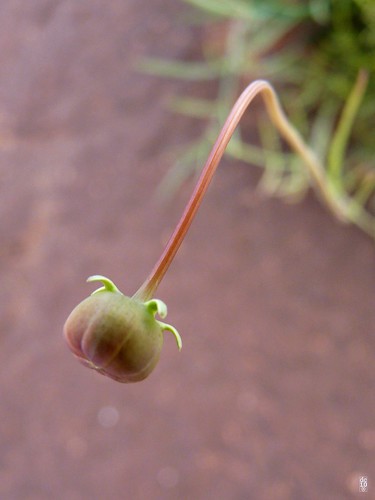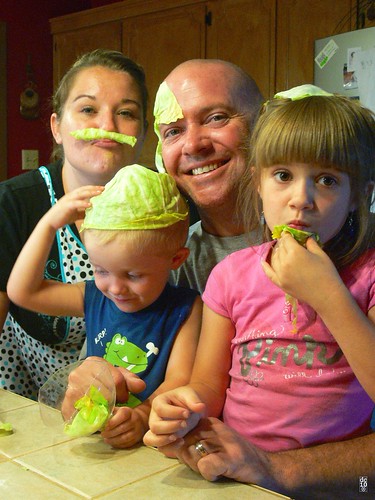
Made with the outer leaves of a head of cabbage, a fun recipe the whole family can enjoy.

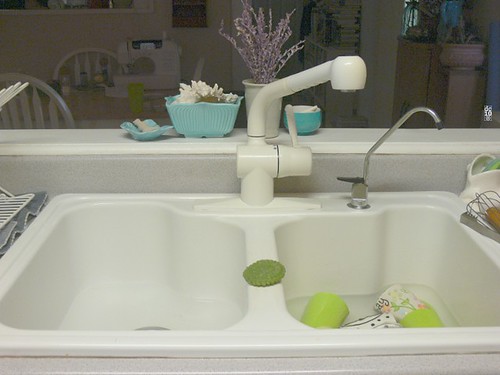
| On Saturday, my daughter, grandkids, and I took our first trip to the Midland Downtown Farmer's Market. Here are the top three things I learned while there. |
 1. Be friendly. 1. Be friendly.Everyone is super friendly, even by Texas standards! But I was especially thrilled to see in person Seiko and Hoven of Milagro Farms in Ft. Stockton, Texas. You see, we had already "met" in a manner of speaking, hanging around some of the same like-minded circles on Facebook, and then friending one another too. From their photos, I've been following along as they've transformed their West Texas family plot with beautiful cacti and rows and rows of healthy food. A photo of Seiko behind a rototiller is quite something to see. Next time they are in Odessa, Hoven wants us to show them around our thrift stores and I want him to look at the insulation in my attic to see what he'd recommend. You know, real friends and friendly stuff. |
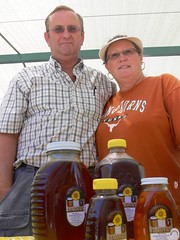 2. Bring that extra $20. 2. Bring that extra $20.I'd suggest you bring a little extra money because you never know what you'll find there that you have been desperately wanting. Me, I had been searching for locally grown honey for ages. I almost kissed Dave and Marta when I saw their Golden Bouquet Honey. For more than thirty years their bees have been working local wildflowers and mesquite blooms. When offered taste samples, I tried both. They really do taste different! Wildflower honey is robust, rich, whereas the mesquite is delicate and fragrant. Clever bees. Actually, I wish I had brought two extra $20s, one for each flavor. (It will come as no surprise to my regular blog followers that I went with wildflower honey. $19.50 for a colossal-size jar.)  3. Next time, arrive at 9 a.m. sharp. 3. Next time, arrive at 9 a.m. sharp.The expression "farm fresh" is truly meaningful at a Farmer's Market. The freshest things sell out, even more so if it is the first time they are available. And sad as it might be for tardy buyers, you gotta be glad hard-working folks are succeeding so splendidly. On the far right is Matt Hanson, aka "Farmer Matt," founder and visionary of MDFM. Currently, he is scouting for even more local farmers to meet the area's growing interest and excitement for local foods. He also invites you hobby gardeners with extra to sell to contact him. And it's not just veggies and fruits, y'all. He's looking for other kinds of local producers, like those who can provide meat, cheese, milk, and eggs for example. Or bakery items, salsas. Anything yummy. If you make it, they will come. |
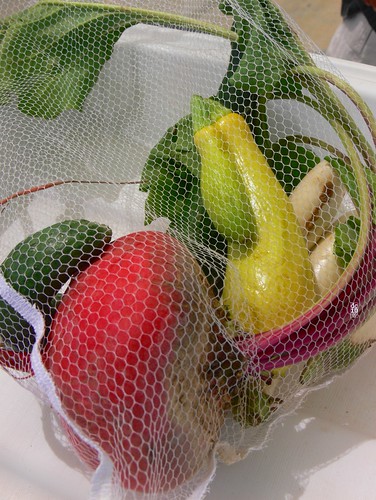 Lastly, I thought you might like to see my reusable produce bag filled with colorful bounty from its inaugural field use. Another Farmer's Market tidbit I observed: most everyone brings their own bags, but in case you forget it's no problem. Everyone there has plenty plastic bags -- don't we all -- saved and brought to use. Lastly, I thought you might like to see my reusable produce bag filled with colorful bounty from its inaugural field use. Another Farmer's Market tidbit I observed: most everyone brings their own bags, but in case you forget it's no problem. Everyone there has plenty plastic bags -- don't we all -- saved and brought to use.A big thanks to Farmer Matt and all the Wonderful Vendors! I'm sorry I couldn't get around to everyone's table to see, smell, and tout your wonderful wares, but rest assured I'll be back for more wholesome goodness. |
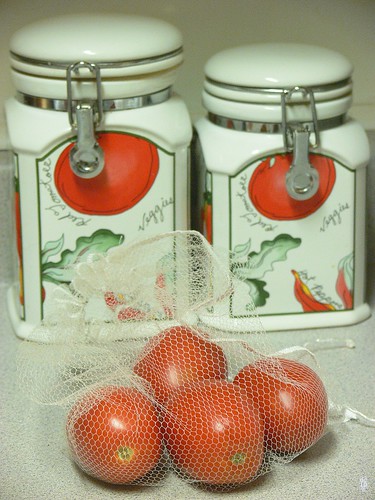
 For my sewing friends, here's a tip on working with net, which is like trying to sew air. For a stabilizer, I used regular paper which I was able to tear away easily when done. Used envelopes, flattened out, would work very well for this purpose.
For my sewing friends, here's a tip on working with net, which is like trying to sew air. For a stabilizer, I used regular paper which I was able to tear away easily when done. Used envelopes, flattened out, would work very well for this purpose. Today my daughter and I are headed to the Midland Downtown Farmer's Market for the first time! I wish it wasn't 30 miles from here. Still, that's a fraction of the distance most produce must travel to get to my local grocery store, I'm sure.
Today my daughter and I are headed to the Midland Downtown Farmer's Market for the first time! I wish it wasn't 30 miles from here. Still, that's a fraction of the distance most produce must travel to get to my local grocery store, I'm sure.
Honorable Congressman Conaway,
I'm writing to you today to urge you to vote against legislation that would impede American access to locally grown food. In particular, I am concerned with S.510 and HR 2749.
This proposed legislation comes at a time when independence and sustainability are at the forefront of American conversations. This bill makes little sense with scant to no evidence supporting security or health vigilance at this level. I see these bills as having the contrary effect of making American families more dependent on centralized food sources (those entities that can afford to meet standardized regulations) resulting in larger vulnerabilities and risks for our country. In addition, more regulation will raise food prices, and give imports an undue advantage not having to meet these on-going inspections.
Next time you are in Midland, I hope you'll visit the Midland Downtown Farmers' Market. Last week they offered free ice cold water, summer produce including squash, tomatoes, onions, garlic, bush beans, and more. The market is growing in popularity and is a fine example of a West Texas unfettered can-do attitude.
Please vote no against over-extending legislation that does no service to the American public and damages our proud self-reliance.
Respectfully yours,
Debi Cates

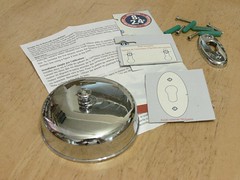 Installing was easy, but I had to build up nerve to drill screw holes in the shower wall. I did some thinking ahead and purposely put the line container part furthest from the shower head, and higher too. That way it's less likely for water to get in, or worse, inside the wall through the screw holes.
Installing was easy, but I had to build up nerve to drill screw holes in the shower wall. I did some thinking ahead and purposely put the line container part furthest from the shower head, and higher too. That way it's less likely for water to get in, or worse, inside the wall through the screw holes.
I celebrate myself, and sing myself.* Walt Whitman (1819-1892) Song of Myself
As I am, I deserve to be. I am no victim of life because I am life.
I embrace my unironable wrinkles, etched by cycles of sun and clouds.
I embrace wild strands of gray hair, coarse and no longer repressed by the comb's convention.
I embrace the sagging chin, worn loose from keeping up.
I've heard the talk of beauty and blooms, of fecundity and fear.
But I do not listen.
Urge and urge and urge,
Always the procreant urge of the world.
There never was so much beauty as now among stalks and stems.
Blooms bud, brighten and wither. Fruits swell, sweeten, and fall.
All grass and stars.
All grass and stars.
Where are you off to, lady?
I dare not loafe.
Let me fill my baskets with the destiny of a woman's labor,
part of the ceaseless folding and unfolding.
I do not call aloud to invite my soul.
Nor do I despise the priests, nor those that consult them.
Let me wash without worry,
My soul follows like the shadows on the line.
I, now fifty-one years old, simply am.
Hoping to cease not till death.
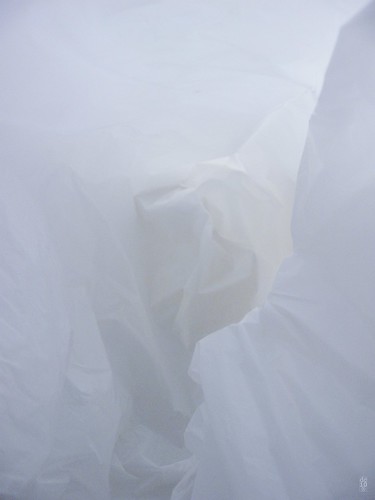
Links
GLAD's ® declaration of dangerous chemicals not used in their production. What is their stuff made of? It's not answered. Probably for a reason.
CNN's article "5 toxics that are everywhere: Protect yourself."
CNN's video "One woman's mission to be plastic-free."
The animated Internet sensation, "The Story of Stuff."
